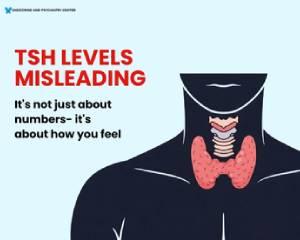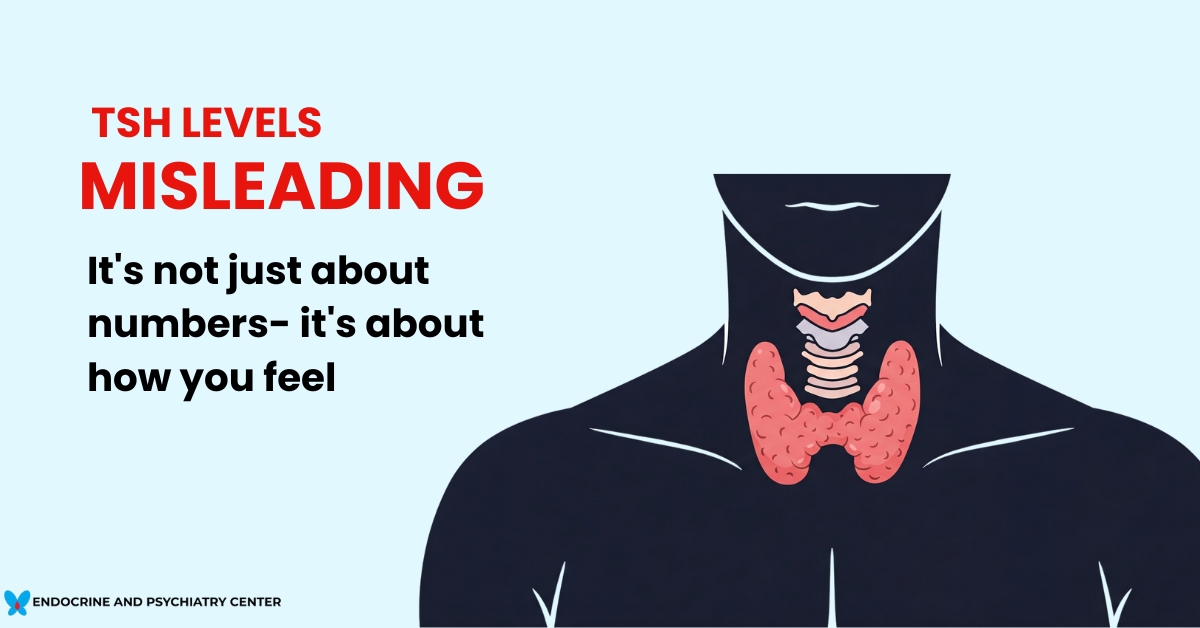- About Us
- Locations
- Meet the Team
-
Patient Resources
-
-
Patient Information
-
-
-
Services
-
-
All Services
-
Proudly Part of Privia Health

Why TSH levels aren’t always what they seem: Understanding the debate on reference ranges

Introduction: What is TSH and Why Should You Care?
If you’ve ever had your thyroid tested, you may have seen TSH on your lab results. But do you know what it means? And why is there so much talk about TSH levels and reference ranges?
This blog is here to break it all down for you.
TSH stands for Thyroid Stimulating Hormone, which is made by the pituitary gland in your brain. It tells your thyroid gland to produce hormones that control your metabolism and energy levels. But lately, there’s been a lot of discussion about whether the reference ranges used to measure TSH are accurate, or if they need to be updated.
Let’s take a closer look at what this debate is all about, and why it might matter for your health.
What Are Reference Ranges and How Do They Work?
Before diving into the controversy, let’s understand what reference ranges are.
A reference range is the range of values that most people’s test results will fall into. These ranges are set based on large groups of people and are meant to help doctors know what is considered “normal” or “healthy.” When you get your TSH test results, your doctor compares them to the reference range to decide if your thyroid is working properly.
For years, the reference range for TSH has been pretty standard, with most labs saying that 0.4 to 4.0 milli-international units per liter (mIU/L) is the “normal” range. But recent research suggests this range might be too broad, and the real story might be more complicated.
The Problem with the Traditional Reference Range
For many years, doctors have used the 0.4-4.0 mIU/L reference range as the standard for diagnosing thyroid problems. However, new research has questioned whether this range is really the best one to use for everyone. Here’s why:
- Not Everyone’s Normal is the Same: The traditional range is based on the average of a wide group of people, but your "normal" may not fit neatly within that range. For some people, even slightly high or low TSH levels could indicate a thyroid problem, while others may feel perfectly fine with TSH levels that fall outside the usual range.
- Changes Over Time: As we age, our thyroid function can change. A TSH level that’s normal for a younger person might not be ideal for an older adult. This has led some experts to suggest that the reference range should change depending on age, gender, or other factors.
- The Role of Symptoms: A person’s symptoms—like fatigue, weight changes, or mood swings—may be more important than the number on your lab report. A TSH result within the reference range doesn’t always mean everything is okay with your thyroid, and a result outside the range doesn’t automatically mean there’s a thyroid disorder.
The Debate Over Narrower Reference Ranges
Some researchers and doctors are now calling for narrower reference ranges for TSH. This means that they believe the “normal” range should be smaller, and anything above or below that could signal a thyroid problem. But why?
- Subclinical Hypothyroidism: A condition called subclinical hypothyroidism occurs when your TSH level is elevated, but your thyroid hormones (like T4 and T3) are still normal. This condition may not cause obvious symptoms, but some doctors believe it could still increase the risk for health problems like heart disease or diabetes. They argue that a narrower TSH reference range might catch this earlier, allowing for better treatment.
- Improved Diagnosis: A narrower range could help doctors diagnose thyroid problems
earlier, especially in people who feel tired or gain weight but have normal TSH levels.
If the reference range is stricter, it may help identify thyroid problems that could be affecting your overall health.
The Case for Keeping the Broader Reference Range
Not everyone agrees that a narrower range is the answer. Many experts argue that the traditional 0.4-4.0 mIU/L reference range is fine the way it is. Here's why:
- No One-Size-Fits-All: Everyone’s body is different, and a narrower range could end up overdiagnosing people who don’t actually have thyroid problems. A slightly higher or lower TSH level doesn’t always mean you need treatment. Some people feel perfectly fine with a TSH level that might be considered “abnormal” by a stricter range.
- Risk of Over-Treatment: If doctors started diagnosing thyroid problems based on a narrower range, more people might be treated with thyroid hormone replacement therapy. Overuse of these medications can have side effects, including heart problems and bone loss. For this reason, some doctors feel it’s better to stick with a broader range and only treat those with obvious symptoms.
What Does This Mean for You?
So, what should you take away from all this? If you’re having your TSH levels tested, it’s important to remember that reference ranges are just a guideline, and they may not always apply to you personally. If your TSH levels fall outside the standard range, it doesn’t automatically mean there’s a problem. Similarly, if your levels are within the “normal” range, it doesn’t necessarily mean everything is perfect.
Here are a few things to keep in mind:
- Talk to Your Doctor About Symptoms: If you feel tired, gain weight, or experience other symptoms, even with a normal TSH level, talk to your doctor. They may look at your thyroid hormone levels, symptoms, and other factors to get a fuller picture.
- Age and Gender Matter: As we mentioned, age and gender can influence thyroid function. Your doctor may take these factors into account when interpreting your TSH levels.
- Don’t Panic Over a Single Test: One TSH test isn’t always enough to diagnose a thyroid problem. Doctors often look at several tests over time, as well as your overall health and medical history, to make a diagnosis.
How to Keep Your Thyroid Healthy
While we’re on the topic of thyroid health, let’s quickly cover a few tips to keep your thyroid working well:
- Eat a Balanced Diet: A healthy diet with enough iodine, selenium, and zinc is important for thyroid function. These nutrients help your thyroid produce hormones properly.
- Stay Active: Regular exercise helps regulate your metabolism, which is linked to thyroid function. Aim for at least 30 minutes of exercise most days of the week.
- Get Enough Sleep: Poor sleep can affect your thyroid health, so try to get enough rest each night. Most adults need 7-9 hours of sleep.
- Manage Stress: Chronic stress can impact your thyroid. Practice stress-relieving activities like yoga, meditation, or deep breathing exercises.
Conclusion: What’s Next for TSH Reference Ranges?
The debate about TSH reference ranges is still ongoing, and there’s no clear answer yet. However, it’s important to know that one number doesn’t define your health. If you’re concerned about your thyroid function or TSH levels, it’s always a good idea to talk to your doctor. They can help you understand what your test results mean in the context of your health and symptoms.
In the end, what’s most important is that you’re feeling your best, whether your TSH levels fall within the “normal” range or not. So keep an open mind, stay informed, and don’t be afraid to ask questions